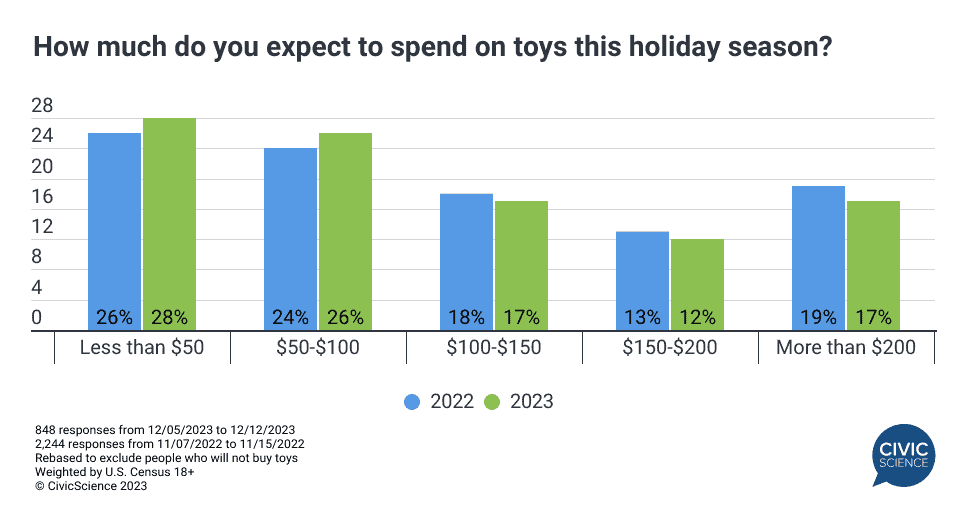Keeping with annual traditions, kids across America are making their lists and checking them twice before handing their wish lists off to their parents. What’s different about this year is that sources predict toy shopping could be down, as toy sales have been slow throughout the year compared to pandemic years. While general economic sentiment has increased in recent weeks, parents say they are experiencing more stress over the impending holidays — so what does that mean for holiday toy spending?
Data from the CivicScience InsightStore™ predicts toy buying for the holiday will be up this year. Polling reveals 33% of U.S. adults plan on buying toys this holiday season, which is four percentage points greater than last year (29%).
However, year-over-year tracking suggests that toy buyers may spend less overall this season. The majority (54%) of toy shoppers plan to spend $100 or less on toys this year, specifically people without kids of their own, compared to 50% last year. Grandparents are more likely than parents to spend $150-$200 on toys, but both are equally likely to spend over $200. Still, while toy purchasing is up compared to last year, overall expected spending on toys has decreased.

Join the Conversation: Do you like or dislike shopping for toys during the holidays?
Category Spending & Major Brands
Puzzles and games, educational toys, and electronics are the most popular toy categories for the third season in a row. The rates of toy buying within each category are similar to last year’s with the exception of educational toys, which saw a drop of five percentage points this year.

The bulk of these toy purchases will be from an online-only retailer such as Amazon, unless you are a parent, in which case data show you are more likely to utilize a big-box store or its website.
When compared to four other major toy brands, LEGO still holds first place for most purchased or planned to purchase as holiday toy gifts. Disney-brand toy purchases are six percentage points lower this year compared to last year, while Hasbro saw a four percentage point decrease.

Correlations With Education Status
The CivicScience InsightStore™ suggests education status could help predict a toy shopper’s purchases. The level of education attained by a shopper had bearing on the three major toy categories. Educational toys are slightly more likely to be purchased by people who have spent time in college, but puzzles and games have a higher buy rate among people who have not gone to college. Shoppers who haven’t been to college are also more likely than their counterparts to purchase electronics as toy gifts this Christmas.
Holiday toy purchases will be strong this year, but overall spending on toys has decreased. LEGO is as popular as while many other leading toy brands have slumped. Online-only retailers are more likely to be toy-buying destinations this year compared to last year.
Understanding who’s buying gifts this holiday season gives brands a leg-up on their competition. Reach out to us to learn more about getting access to the CivicScience InsightStore™.
Take Our Poll: Is it OK for adults to play / build with LEGO bricks? 🧱








